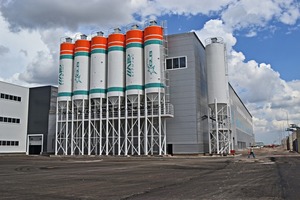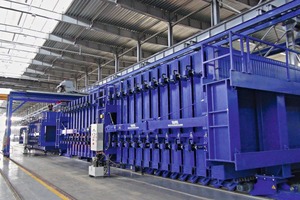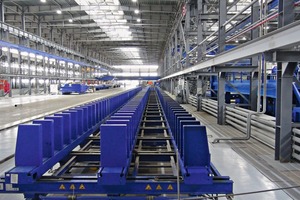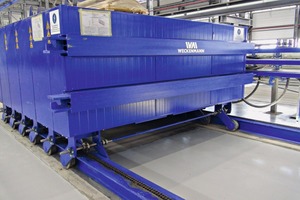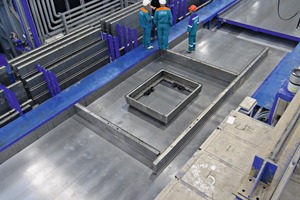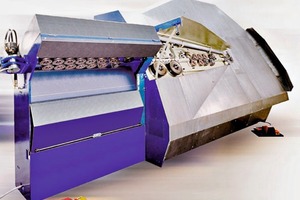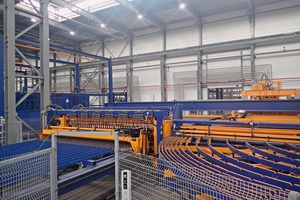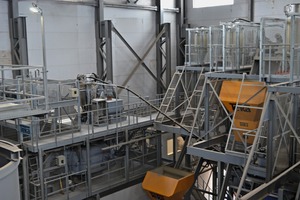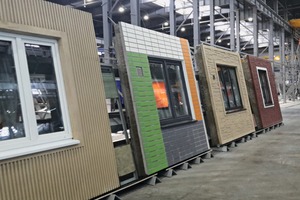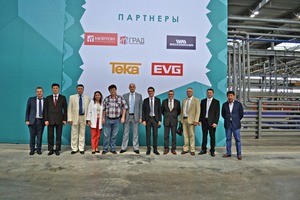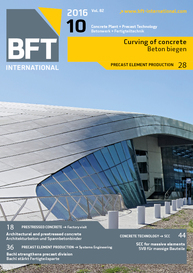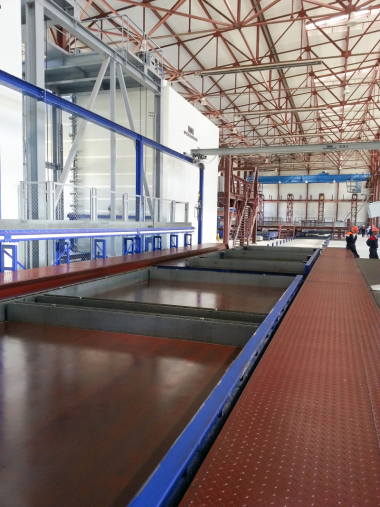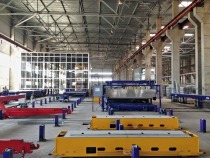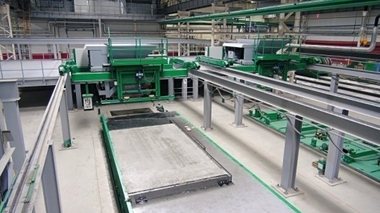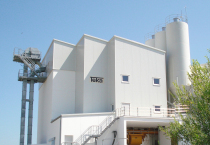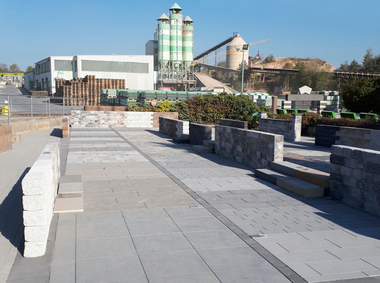Kazakhstan’s largest precast concrete plant inaugurated
Recently, the Kazakh concrete specialist GLB has put his new production facility in Astana into operation – with an overall area covering 15 hectares it is the largest precast concrete plant in Kazakhstan for the time being. The German equipment and machinery manufacturer Weckenmann was commissioned with the implementation of this demanding project as principal supplier and coordinator.
GLB is a subsidiary company of Shar Kurylys, a big building contractor headquartered in Astana. Up to now, Shar Kurylys has bought their precast concrete elements from external sources, but the company decided to produce the precast concrete products themselves owing to the growing demand. The new GLB precast concrete plant, which is an important investment for the city of Astana and for Kazakhstan as a whole, is now manufacturing about 250.000 m² of living space annually. The circulation system used for mixed production (sandwich elements, walls, floors and customized elements) has a capacity of approx. 1,300 m² of precast concrete elements per day. The construction period needed for a turnkey, 16-story building can be reduced from so far 18 to 6 months by means of the new production plant.
The finished elements correspond to modern international standards; the buildings are state-of-the-art in respect of thermal and sound insulation. 90 % of the materials for the construction are purchased from Kazakhstan; the plant equipment is “made in Germany” and is based on the latest technical developments, too.
Importance and equipment of the plant
The Swabian machinery and equipment manufacturer Weckenmann was commissioned with the initial planning and implementation of the project. Soon after the custom-made solution was officially opened on June 22, 2016, the Kazakh President Nursultan Nasarbajew also visited the plant amid great public interest. He was impressed by the production facility and drew attention to the importance and need of the plant in the implementation of the government housing program. The state of Kazakhstan has launched the program “Business Road Map 2020” for ensuring the creation of jobs and safeguarding them as well as sustainable growth of the Kazakh economy.
The precast concrete plant comprises eight manufacturing areas (text box). The circulation system with 40 formwork pallets is the core component of the plant. In the second hall bay, up to 1,500 m² of precast concrete elements are manufactured per day on three battery molds of the latest generation. The circulation system is conducted by the Wavision master computer of Weckenmann; the computer takes over the central production planning and control of the factory. The control solution consists of several modules and makes use of all data available in the company, thus unifying administration, work preparation, production and reporting in one modular system.
The stationary production line is equipped with four tilting tables, a helicopter trowelling machine, a battery mold for the production of staircases, a column formwork unit with tensioning device and a concrete spreader. Four bucket conveyors provide for the concrete transport to the respective manufacturing area.
The formwork department of Weckenmann conceived a formwork system that is ideally adapted to the production process. The solution for an optimum production process is the M-Series formwork system. This series is excellently suited to the production of solid elements with customer-specific chamfer and profiling. In addition, the formwork profiles are equipped with integrated switchable magnets allowing for automated handling. The X-Uni formwork system is used for the tilting table production line. Magnetically fixable fastening system for wooden formwork enables the flexible production of a wide variety of products.
Concrete mixing plant of Teka
Teka Maschinenbau GmbH was assigned with the supply and erection of one of the largest concrete mixing plants all over the world. The plant consists of five completely stand-alone and independent mixing stations in juxtaposition.
The complete mixing plant consists of a high-performance Teka turbine mixer type THT 2250 for the production of face mix concrete as well as two well-known Teka high-performance planetary mixers type TPZ 2250 with an output of 1.5 m³ per batch each, a mixing station with the Teka high-performance planetary mixer type TPZ 3000 with an output of 2.0 m³ per batch for the production of precast elements and a mixing station with Teka high-performance pan mixer type THZ 3000 for ready-mixed concrete.
Several hundred times in operation for the production of precast concrete, the Teka high-performance planetary mixers have proven their worth and are the core component of every Teka batching and mixing plant.
The Teka high-performance mixers of type TPZ 2250 and TPZ 3000 with a concrete output of 1.5 m³ and 2.0 m³ each per batch were chosen as mixer sizes.
For face mix concrete and colored concrete, GLB also opted for a Teka turbine mixer because this mixer is ideally suited for frequently changing batches. This mixer is often selected for special mixing tasks such as face mix concretes, colored concretes, self-compacting concrete or ultra-high performance concrete. The turbine mixer is able to mix even small batch sizes of below 10 % perfectly, has a much lower degree of contamination and an extraordinarily short discharge times; this is added by low cleaning and maintenance costs.
The well-known and proven Teka pan mixer with an output of 2 m³ was selected for ready-mixed concrete. The mixing plant control comprises five individual control systems split to four locations. Three independent control units for the feeding process and two for the mixing plant with a total of 17 operating units provide for smooth interaction.
Reinforcement production line of EVG
The fully-automated wire mesh welding machine of type HFBE/158 is the focus of the reinforcement production line; the machine manufactures flat reinforcement elements up to a size of 3.6 x 8.0 m in any dimension, shape as well as with window and door openings. Afterwards, vertical work stations are used to assemble the finished reinforcement wire mesh to three-dimensional reinforcement cages, which are transferred to the circulation system and/or the battery molds of Weckenmann. In addition, it is also possible to combine various line wire and cross wire diameters within a wire mesh.
In the welding line the bars are welded to each other at pre-defined spots in a resistance welding process. A wire mesh crane transfers the finished reinforcement elements to a roller conveyor, which in turn carries the wire meshes to the work stations. These reinforcement elements are required for the reinforcement of two-dimensional concrete elements such as solid walls, sandwich panels or floor elements.
The automatic stirrup bender PBC 2-12 allows processing of rebars in the diameter range of 6.0 to 12.0 mm from the coil. The rebars are automatically taken from the coils, straightened, bent and cut afterwards. All these working steps are carried out in a fully automated process with high precision and repeatability. The program control is able to record the data of several thousands of stirrup shapes for recalling them again.
The stirrup bending machine is designed for the production of two- and three-dimensional stirrups.
Conclusion and outlook
Since the specialists of Weckenmann have attended the customer right from the beginning as project coordinator, the teams have already closely collaborated in the design stage and the design of the construction system as well as the plant layout, the plant concept from project management up to commissioning the turnkey plant. The well-coordinated project team consisting of Weckenmann, EVG and Teka supplied a customized solution; the close cooperation with the engineers of GLB and Shar Kurylys run very smoothly on a partnership basis.
In this way, a project of the superlative has been built up in Astana. By the 1st of May 2017, the first – more than 1,000 homes – are said to be completed.

